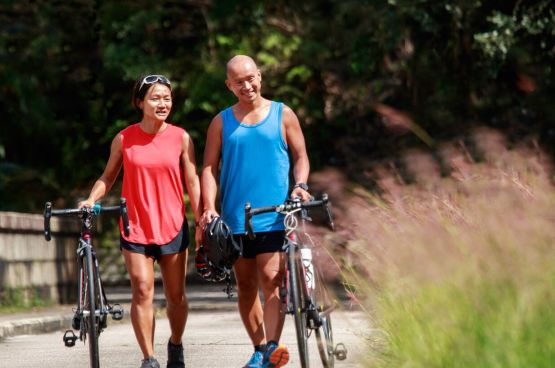How to stay fit as a new parent
When you’ve recently become a new parent, working out may be the last thing on your mind. But looking after your own health and wellbeing can help you to cope. Here, I’ll explore how you can stay fit as a new, and probably tired, parent.

When is it safe to exercise after birth?
If you have recently given birth, then your exercise concerns may go beyond just being tired. It’s usually recommended to start slow. So, you could try some gentle, low impact movements such as walking. But only when you feel like it.
For more intense exercise such as running or aerobics, it’s usually a good idea to wait until after your postnatal check-up 6 weeks after birth.
You will likely find your abdominal (tummy) muscles will be weaker than before birth. You may also have some extra flexibility which can cause injury if you over-exercise. If you’ve had a C-section, or experienced other complications at birth, make sure to see a doctor for extra support.
The good news is that there seems to be a link between women who stay active after giving birth and a reduced risk of postnatal depression. So doing what you can to stay active may support your mental health at this time.
How to exercise when you’re tired
Unsurprisingly, many new parents experience a loss of sleep. This can make it hard for you to feel motivated to work out. Below are a few ideas that could help.
Take a short stroll
If you’re low on energy, then try to focus on doing short and gentle movement sessions. This could include taking a 10-minute walk around the block. It might be that once you get going you feel able to do more moment, as exercise can increase your energy levels.
But, at the very least you’ll have had a short stroll in the fresh air (ideally in nature), which can make you feel more alert and focused.
Try movement snacking
Movement snacking is where you introduce short, varied movements into your daily life. The idea is that you make good exercise habits by linking a movement with a regular daily behaviour. For example, you could do a few squats when waiting for the kettle to boil – or you could do a few stretches when your baby goes down for a nap.
This is less demanding than trying to fit in a longer, more formal exercise session when you’re tired – but can still help you to keep active during the day.
How to exercise with your baby
Instead of trying to create time to work out alone – why not bring your baby along too? There are now a number of mum and baby yoga classes for example.
You could also find a local ‘buggyfit’ class. This is when you bring your baby out in a buggy with other parents. You will do exercises as a group, usually in a park or outdoor area. Here, you can also enjoy meeting and socialising with other new parents – which has its own health benefits.
Another option is to put your baby into a wearable carrier and do some simple bodyweight exercises such as squats and lunges. Just make sure baby is carefully secured before you move.
Seek help from your family and friends
Sometimes you might want to have a little break from your baby. If so, you could ask a friend or family member to watch them for an hour. You could also take an online class from home. There are many free options available online now.
Another idea is to ask if your local gym or fitness centre has childcare facilities. Then you can focus on working out, knowing that your baby is being well looked after.
Adjust to your baby’s routine
You might find you need to start exercising at unconventional times. For example, if your baby is sleeping early in the morning, this might be a good time to fit a short session in.
Otherwise, try to arrange your exercise schedule to fit in with their daily routines. This might involve exercising either earlier or later in the day than you are used to. But, it makes use of the time when your baby is asleep and means you can prioritise your health and wellbeing in the process.
Are you interested in learning more about your health? Discover more about our range of health assessments.
-
Sources Sources
- Postnatal exercise. National Childbirth trust. www.nct.org,uk, last reviewed April 2018
- Exercise after the birth: the first six weeks. Baby Centre. www.babycentre.co.uk, accessed 23 March 2023
- Keeping healthy with a baby. NHS UK. www.nhs.uk, last reviewed August 2020
- Teychenne M, et York R. Physical activity, sedentary behaviour, and postnatal depressive symptoms – a review. American journal of preventative medicine. 2013;45: 217-227
- How does being a new parent effect sleep? The Sleep Foundation. www.sleepfoundation.org, Updated 7 February 2023
- Loy B, Connor P et Dishman R. The effect of a single bout of exercise on energy and fatigue states – a systematic review and meta analysis. Fatigue Biomedicine Health & Behavior. 2013(4):223-242.DOI:10.1080/21641846.2013.843266
- Thriving with nature. Mental health Foundation UK. www.mentalhealth.org.uk, 2021
- Mother and baby yoga. National childbirth trust. www.nct.org.uk, accessed 23 March 2023
- Relationships and communities (statistics). Mental Health Foundation UK. www.mentalhealth.org.uk, accessed 23 March 2023
About our health information
At Bupa we produce a wealth of free health information for you and your family. This is because we believe that trustworthy information is essential in helping you make better decisions about your health and wellbeing.
Our information has been awarded the PIF TICK for trustworthy health information. It also follows the principles of the The Information Standard.

More exercise and fitness articles
Did you find our advice helpful?
We’d love to hear what you think. Our short survey takes just a few minutes to complete and helps us to keep improving our healthy lifestyle articles.
Legal disclaimer
This information was published by Bupa's Health Content Team and is based on reputable sources of medical evidence. It has been reviewed by appropriate medical or clinical professionals and deemed accurate on the date of review. Photos are only for illustrative purposes and do not reflect every presentation of a condition.
Any information about a treatment or procedure is generic, and does not necessarily describe that treatment or procedure as delivered by Bupa or its associated providers.
The information contained on this page and in any third party websites referred to on this page is not intended nor implied to be a substitute for professional medical advice nor is it intended to be for medical diagnosis or treatment. Third party websites are not owned or controlled by Bupa and any individual may be able to access and post messages on them. Bupa is not responsible for the content or availability of these third party websites. We do not accept advertising on this page.







